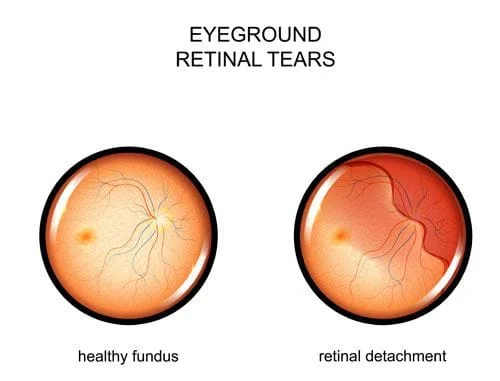Our ophthalmologist office near San Diego is available for retinal tear treatment.
Retinal tears are common, but they should be treated quickly to avoid vision loss.
What is a Retinal Tear?
Your retina is made up of photosensitive cells that communicate with your brain, thus allowing you to see. It's quite thin and sometimes tears are part of the aging process. A tear will allow fluid to enter the inside of the eye, leading to a retinal detachment. That's why It's vital to have the problem addressed quickly by Dr. Nathan Anderson.
Why do Retinal Tears Happen?
The eye is filled with vitreous, a gel-like substance that breaks down and becomes more watery as we age. In people older than 60 years of age, this process often causes the vitreous to separate from the back of the eye. When this occurs, you are at risk of developing a retinal tear. The vitreous moves more easily when detached from the back of the eye, so it's very easy to develop a tear in your retina during the course of common, everyday movements. Some people are at higher risk for retinal tears, including those with:
- Nearsightedness,
- Retinal thinning,
- Previous cataract surgery,
- A history of eye trauma,
- A family history of retinal tears,
- Retinal tears in the other eye.
Symptoms of a Retinal Tear
Symptoms of retinal tears include flashes of light in the eye and seeing floaters in your eye. Retinal tears can also cause bleeding into the eye, which causes multiple floaters and vision loss.
Retinal Tear Treatment
Dr. Anderson can diagnose a retinal tear during an eye exam. He or she may press on your eye to fully assess the problem. If a retinal tear is present, immediate treatment is required to prevent retinal detachment.
Retinal tears are corrected through the creation of scar tissue around the rear. Scar tissue prevents fluid from entering the eye. There are two methods to build scar tissue.
First and most common, laser photocoagulation creates tiny burns around the tear. Scar tissue is formed as the burns heal. The less common method is cryopexy.
This may be recommended if the presence of blood prevents Dr. Anderson from seeing the tear. A cryoprobe is placed on the outside of the eye and becomes very cold, creating freeze burn around the tear. Scar tissue is created during the healing process.
Following either type of treatment, you should not jar your head or move it suddenly for about two weeks or until scar tissue is fully formed.
For more information about spinal decompression, contact Anderson Family Ophthalmology at 800-462-8749.


